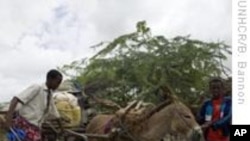<!-- IMAGE -->
The U.N. refugee agency is appealing for $2.8 million to help more than 300,000 refugees in two camps in Kenya threatened by flooding. The UNHCR says the mainly Somali refugees in Kenya's overcrowded Dadaab camps urgently need to be protected from the worst effects of the torrential rains.
Most of Kenya is suffering from the effects of the prolonged drought. But, along the Indian Ocean Coast and the northeastern region of the country, people are being pounded by torrential rainfall.
The United Nations reports thousands of people have lost their homes and livelihoods, and, it warns flooding and landslides from the rains may affect up to 750,000 people.
U.N. refugee spokesman, Andrej Mahecic, says many of those affected by the flooding are Somali refugees living in Kenya's overcrowded Dadaab camps.
"We fear that the looming El Nino phenomenon…a change in the atmosphere and ocean of the tropical Pacific region that produces floods, droughts and other weather disturbances in many regions of the world-may now threaten the 338,000 mostly Somali refugees in the two camps, which in any case usually are flooded for three months every year," he said.
Although the yearly floods are predictable, Mahecic says the UNHCR is limited in what it can do ahead of time to protect the refugees from their destructive impact.
He notes the government gives the ground for the campsites and the UNHCR is unable to move the refugees to safer land without permission from the Kenyan authorities.
He says the Dadaab camps are a good example of the dilemma faced by the agency and the refugees who reside there.
"It was initially planned to hold 90,000 people," said Mahecic. "Perhaps if it held the original population, the situation would have been different. Perhaps the camp would be smaller and less effected by potential flooding. However, it is now three times its original size in terms of population, not in terms of land. It makes it extremely difficult to change the site once you have it there."
Mahecic says the UNHCR began digging trenches and placing sandbags around hospitals, bore holes and other strategic locations in both camps, when heavy rains started three weeks ago.
He says many sections of the camps would have been inundated without these and other measures. He says the agency is planning to move refugees who might be worst affected by the floods to higher ground within the camps.
He says much of the money from the appeal will be used to pre-position essential items such as fuel, blankets, plastic sheets, and to respond to possible outbreaks of disease.





